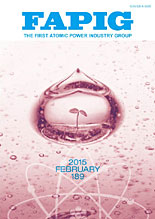![]()
FAPIG
THE FlRST ATOMlC POWER INDUSTRY GROUP
FAPIG誌 最新号目次
2015−2/平成26年度 第2号(No.189)

|
目 次 ■ 報 告 ■ 紹 介 FAPIGの機構 (25) 表紙デザイン:中川 敏
CONTENTS ■ Report ■ Introduction Cover Design:Satoshi Nakagawa
SYNOPSES Takeshi Izumi, Makoto Komatsu, Tatsuya Deguchi From the viewpoint of the minimizing the corrosion of the spent fuel
rods and structural material in the spent fuel pool, the ion exchange
resins are generally used as one of purification system in order to
keep water quality clean. Keisuke Fukumoto, Tomoya Minagawa, Osamu Maekawa As an emergency radiation monitoring system in case of nuclear disaster, an innovative system which consists of a Portable Monitoring Post, Monitoring Vehicle and server located in the data center was developed. Portable Monitoring Post can easily be delivered and installed anywhere. The Monitoring Vehicle is capable of measuring radiation while driving. And, the server summarizes the measured data, and displays the measuring points and measured values on the map. The server's display screen and functions make it possible to publish the monitoring data such as dose level, trend and distribution map through the Internet network. KEYWORDS:emergency radiation monitoring system, nuclear disaster, portable monitoring post, monitoring vehicle, easily delivered, measuring radiation while driving, measuring points and measured values on the map, dose level, distribution map Norio Yabe, Naoki Shiraishi The MODON Environment Management System (MEMS) project started with a feasibility study on eco-industrial cities as part of the "Fiscal Year 2011 Project Commissioned to Research and Promote Infrastructure-related System Export (Business Feasibility Study on Smart Communities in the Global Market)" sponsored by the Japanese Ministry of Economy, Trade and Industry (METI). This led to Fujitsu being awarded a contract to construct ambient air, emission air, and ambient, industrial water, and wastewater systems in three major industrial cities covered by MODON, which means "cities" in Arabic. This construction was carried out in collaboration with Fuji Electric Co., Ltd., METAWATER Co., Ltd., Eco Analysis Corporation, Mizuho Bank, Ltd., and experts in many different fields from academia and Kawasaki City. KEYWORDS:Saudi Arabia, eco industrial city, smart communication, environment, monitoring, ambient air, emission air, wastewater Noriaki Nakao The construction of an interim storage facility is planned in Fukushima for decontaminated waste collected in the decontamination process after the Fukushima Daiichi Nuclear Power Plant accident in 2011. For the real-time radiation-risk communication tool in this facility, a scintillation fiber detector coupled with LED was developed as a real-time visible radiation monitor that displays LED colors at the corresponding locations for the corresponding radiation levels. The detector consists of a plastic scintillation fiber detector as a position-sensitive radiation detector, an LED line tape, and a control unit to link the LED lighting. This detector can visibly monitor the radiation level in real time and in continuous position, and it is useful for visible radiation monitoring at locations such as the site boundary, conveyor belt, and high-level radioactive waste storage for radiation safety and risk communication with radiation workers and residents around the site. KEYWORDS:interim storage facility, decontamination, risk communication, LED, plastic scintillation fiber, position sensitive, site boundary, visible radiation monitoring, radiation safety |
バックナンバー目次
|
号数 |
発行年月 |
| 188 | 2014/ 9 |
| 187 | 2014/ 2 |
| 186 | 2013/ 7 |
| 185 | 2013/ 2 |
| 184 | 2012/ 7 |
| 183 | 2012/ 2 |
| 182 | 2011/ 2 |
| 181 | 2010/ 7 |
| 180 | 2010/ 2 |
| 179 | 2009/ 7 |